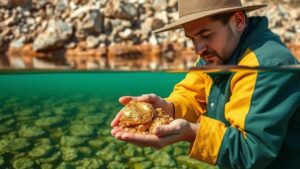Spotting Gold-Bearing Sediments in Slow-Moving River Sections
Spotting Gold-Bearing Sediments in Slow-Moving River Sections
The quest for gold has captivated human interest for millennia, and, while modern mining techniques can yield substantial returns, gold prospecting in natural settings still offers thrill and opportunity. One particularly strategic approach is to identify gold-bearing sediments in slow-moving river sections. This article explores how to spot these sediments effectively, providing insights supported by proven methodologies and real-world examples.
The Basics of Gold Deposition
Gold is a dense and heavy metal that often accumulates in low-energy environments, such as the eddies and pools of slow-moving rivers. Understanding the mechanics of sediment transport helps prospectors identify potential gold deposits. When river currents slow, their capacity to carry sediment decreases, causing heavier particles, including gold, to settle.
- Hydraulic Sorting: As water flows over the riverbed, different particle sizes are sorted by weight and size. Gold, due to its high density, can settle quickly into cracks or beneath larger rocks.
- Concentration Zones: Natural features such as bends in rivers create areas of reduced velocity, leading to the accumulation of heavier sediments.
Field Indicators of Gold-Bearing Sediments
When prospecting in slow-moving river sections, several environmental indicators can hint at the presence of gold. Here are vital signs to observe:
- Altered Vegetation: Areas with gold-bearing sediments often feature distinct plant life, as certain species thrive in mineral-rich soils.
- Black Sand Presence: The presence of black sand suggests higher densities of heavy minerals and is often indicative of gold deposits nearby.
- Gravel Bars and Benches: Locations where gravel accumulates, particularly near the banks and bends, are prime spots for gold deposition.
Techniques for Sampling and Testing
Once potential gold-bearing sites are identified, accurate sampling techniques are critical. The following methods are commonly employed:
- Panning: A traditional method where sediments are placed in a pan and washed with water. The denser gold particles settle at the bottom.
- Sluicing: This involves using a sluice box, a trough-like structure that captures gold as water flows through, enabling higher quantities of material to be processed.
- Sampling with a Vacuum Dredge: This technique employs suction to gather sediments from the riverbed, allowing for systematic testing of deeper layers.
Case Studies: Historical Riches
Several regions have become renowned for their gold deposits in slow-moving river segments. following examples highlight historical successes:
- California Gold Rush (1848-1855): The discovery of gold in the Sacramento Valley showcased the potential of slow-moving river sections, where many prospectors found substantial yields from gravel beds.
- Klondike Gold Rush (1896-1899): In the Yukon Territory, prospectors capitalized on slow-moving rivers and their tributaries, leading to remarkable finds of gold-bearing gravels.
Environmental Considerations
While prospecting can be rewarding, it is essential to consider environmental impacts. Miners must adhere to local regulations that govern land use and water pollution. Sustainable practices can help preserve ecosystem health while allowing for responsible exploration:
- Minimize Disturbance: Avoid excessive disruption of natural habitats by practicing careful sediment extraction methods.
- Use Non-Toxic Chemicals: Always opt for environmentally safe alternatives in testing and refining processes.
Actionable Takeaways
Spotting gold-bearing sediments in slow-moving river sections requires observant skills and practical understanding of geological features. Here are key takeaways for aspiring prospectors:
- Look for areas with reduced water flow such as bends, pools, and behind obstruction points like boulders.
- Monitor environmental indicators such as black sands and unique vegetation patterns.
- Use traditional gold panning or sluicing methods to effectively test sites for gold presence.
- Always prioritize responsible and sustainable mining practices to protect local ecosystems.
By blending scientific understanding with practical strategies, individuals can enhance their prospecting endeavors, potentially leading to rewarding discoveries in the realm of gold within slow-moving river sections.

